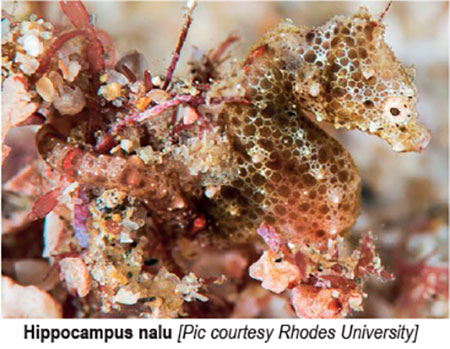News
First pygmy seahorse in Indian Ocean discovered

A pygmy seahorse about the size of a grain of rice has been first observed in the Indian oceans by a group of researchers including including Research Associate of Zoology and Entomology at Rhodes University, Professor Louw Claassens, Rhodes University said on its official web site yesterday.
Finding the new species in in the Indian ocean was very rare, the researchers stated.
“It’s like finding a kangaroo in Norway,” says Richard Smith, a marine biologist based in the United Kingdom and co-author of a new study on the species, known as the African or Sodwana Bay pygmy seahorse. The second name refers to the location where it was found, a popular scuba-diving spot close to the Mozambique border.
The finding shocked them because all seven species of pygmy seahorse, except for one in Japan, inhabit the Coral Triangle, a biodiverse region of more than two million square miles in the southwestern Pacific. This one lives 5,000 miles away, the first pygmy seahorse seen in all of the Indian Ocean and the continent of Africa.
The new species looks somewhat similar to other pygmy seahorses, except that it has one set of spines on its back that have sharp, incisor-like points on the tips, says co-author Graham Short, an ichthyologist at the California Academy of Sciences and the Australian Museum in Sydney. In contrast, the other similar pygmy seahorses have flat-tipped spines.
“We really don’t know what these spines are used for,” Short says. “Many species of seahorses in general are spiny, so their presence could be possibly due to sexual selection—the females may prefer spinier males.”
The surprising discovery, described in a study published May 19 in the journal ZooKeys, shows how little we know about the ocean, particularly when it comes to tiny creatures, the authors say—and that there are likely many more pygmy seahorse species to be identified.
Dive instructor Savannah Nalu Olivier first stumbled upon the creature in Sodwana Bay in 2017, while examining bits of algae on the seafloor. The bay is known for having many species of rare fish, sharks, and sea turtles.
She shared photographs of the fish with her colleagues, and in 2018 they made their way to Smith, who, with colleague and Research Associate of Zoology and Entomology at Rhodes University, Louw Claassens, collected several specimens of the animal at depths of 40 to 55 feet.
The researchers have named the new seahorse Hippocampus nalu, after Olivier, whose nickname is appropriately “Fish.” (She’s also a Pisces.) In the South African languages Xhosa and Zulu, “nalu” roughly translates to “here it is.”
“I told her that this was a gift from the sea,” says Louis Olivier, Savannah’s father, who owns a scuba diving outfit called Pisces Diving Sodwana Bay. He adds he’s “super stoked about her discovery.”
Smith sent several specimens of the new species to Short, who analyzed their genetics and body structures using a CT scanner.
His research revealed that, like other pygmy seahorses, the newly found animal has two wing-like structures on its back, rather than one, as in larger seahorses. These “wings” in general serve an unknown purpose for seahorses.
Also like other pygmy seahorses, the African species has only one gill slit on its upper back, instead of two below each side of the head, like larger seahorses—another mystery.
That would be “like having a nose on the back of your neck,” Short says.
But the new seahorse is unique from its tiny kin in that it was found living in turf-like algae, amid boulders and sand. Sodwana Bay has large swells, and the little seahorses appear to be comfortable being swept about, says Smith, who observed a pygmy seahorse get covered in sand and then wriggle its way out.
“They regularly get sand-blasted,” says Smith, who wrote a book about sea creatures called The World Beneath. Other pygmy seahorses, which stick to the calmer waters around coral reefs, “are more dainty. But this [species] is built of sturdier stuff.”
Like other pygmy seahorses, the African version is thought to eat tiny copepods and crustaceans. It also is well camouflaged to match its surroundings.
This finding “demonstrates that there are still many discoveries to be made in the oceans, even in shallow waters near the coast,” says Thomas Trnski, head of natural sciences at the Auckland Museum in New Zealand, who wasn’t involved in the study. Almost all pygmy seahorses have been discovered in just the last 20 years, he adds.
The only pygmy seahorse found outside the Coral Triangle is the Japanese pygmy seahorse, also known as the “Japan pig,” first described in August 2018.
Although populations of regular seahorses have fallen in many areas because of harvesting for use in traditional Chinese medicine and the aquarium trade, that’s not an issue for pygmy seahorses because they are difficult to find, Short says. That being said, some of these species have very low population densities, and there’s not enough data to get a good sense of how many there are, Smith adds.
These fish can spread only very short distances via the current. The study suggests that Hippocampus nalu diverged from the ancestors of all known pygmy seahorses species more than 12 million years ago.
“This means that it is extremely likely that there are many more species of pygmy seahorses yet to be discovered in the western Indian Ocean” and beyond, Short says.
News
Lankan aircrew fly daring UN Medevac in hostile conditions in Africa

The Sri Lanka Aviation Unit operating under the United Nations (UN) mandate in the Central African Republic (CAR) has successfully carried out a critical Casualty Evacuation (CASEVAC) mission, under extremely hostile and volatile conditions.
The mission had been launched in response to an urgent request to evacuate two United Nations personnel who had sustained combat-related injuries in the Zemio area, the Sri Lanka Air Force (SLAF) said.
Accordingly, the evacuation has been conducted using a Mi-17 helicopter (UNO 325P).
The aircraft was captained by Wing Commander Nelson De Silva, with Flight
Lieutenant Arunoda Ekanayake serving as co-pilot.
The aircrew comprised Squadron Leader Sandeepa Wijayathunga, Sergeant WCN Senevirathne, and Corporal DVPM Rodrigo. The Aeromedical Evacuation Team included Group Captain Sujith Perera, Flight Sergeant KW Sumedha, and Flight Sergeant RDH Karunadasa, who provided critical in-flight medical care to the casualties, the SLAF stated.
The extraction site was located approximately 20 kilometres northeast of the Zemio Permanent Operating Base (POB) and posed significant operational challenges.
They included extremely dusty landing conditions, an unstable and rapidly evolving tactical environment, and the requirement for a precision landing under constant threat, the SLAF said.
Despite these constraints, the aircrew demonstrated remarkable courage, sound judgement, and outstanding airmanship throughout the operation.
A comprehensive threat assessment conducted by the aircraft commander, taking into account the critical condition of the casualties, reflected exceptional adaptability and operational decision-making, the statement added.
According to the SLAF, the total flight duration of the mission was one hour and 45 minutes. The injured personnel were safely evacuated from the hostile location and successfully transported to Bangui for advanced medical treatment.
News
Lanka to observe National Safety Day today

Sri Lanka will mark National Safety Day today (26) with countrywide religious observances, a national moment of silence and the main state commemoration at the Peraliya Tsunami Memorial in Galle, officials said yesterday.
The annual observance, declared in the aftermath of the 2004 Indian Ocean tsunami that claimed over 35,000 lives and left more than 5,000 people missing, is held each year to honour victims of the tsunami and other disasters, while reinforcing public awareness on disaster preparedness.
Disaster Management Centre (DMC) Director General Retired Major General Sudantha Ranasinghe said the 2025 programme would be conducted with due consideration to prevailing weather conditions caused by the Ditwah cyclone, with district-level multi-religious observances planned across the country.
“National Safety Day is a moment of remembrance and reflection. It also reminds us of the importance of preparedness, early warning and community resilience,” he said.
The main national commemoration will take place at the Peraliya Tsunami Memorial from 8.30 a.m. to 11.00 a.m., with the participation of government representatives, religious leaders, disaster survivors and families of victims.
Secretary to the Ministry of Defence Air Vice Marshal (Retd) Sampath Thuyacontha said a two-minute silence will be observed nationwide from 9.25 am to 9.27 am today, in memory of all those who lost their lives to the tsunami and other disasters.
“All institutions and members of the public are requested to observe this moment of silence as a mark of respect and national solidarity,” he said.
DMC Additional Director General Pradeep Kodippili urged the media to provide wide coverage to the main commemoration in Galle as well as district-level programmes organised through District Secretariats.
“Media support and public participation are essential to ensure that the lessons of past disasters remain alive and that a culture of safety is strengthened across the country,” Kodippili said.
National Safety Day has been observed annually on December 26 since 2005.
By Ifham Nizam ✍️
News
Street vendors banned from Kandy City

All forms of street vending within the Kandy Municipal Council area will be banned from January 1, Mayor Chandrasiri Wijenayake has said.The Kandy Mayor said the decision had been taken as part of efforts to preserve it as a clean and aesthetically pleasing city and to allow the public to move freely while enjoying its surroundings.
He said the ban would apply not only to streets in the city centre but across the entire municipal council area. The move, he added, follows long-standing public requests for a more systematic regulatory framework within the Kandy urban area and is aimed at ensuring public convenience and welfare.
Wijenayake stressed that the decision would be implemented without reversal.
The Kandy Municipal Council has already issued formal notices to pavement vendors directing them to cease operations. Street vendors had requested a three-month grace period to relocate, which will expire on December 31.
By S. K. Samaranayake ✍️
-

 News4 days ago
News4 days agoMembers of Lankan Community in Washington D.C. donates to ‘Rebuilding Sri Lanka’ Flood Relief Fund
-

 Latest News7 days ago
Latest News7 days agoLandslide early warnings issued to the districts of Badulla, Kandy, Kurunegala, Matale and Nuwara-Eliya extended till 8AM on Sunday (21)
-

 News5 days ago
News5 days agoAir quality deteriorating in Sri Lanka
-

 Business6 days ago
Business6 days agoBrowns Investments sells luxury Maldivian resort for USD 57.5 mn.
-

 News2 days ago
News2 days agoBritish MP calls on Foreign Secretary to expand sanction package against ‘Sri Lankan war criminals’
-

 Editorial7 days ago
Editorial7 days agoCops as whipping boys?
-

 Features6 days ago
Features6 days agoHatton Plantations and WNPS PLANT Launch 24 km Riparian Forest Corridor
-

 News5 days ago
News5 days agoCardinal urges govt. not to weaken key socio-cultural institutions













